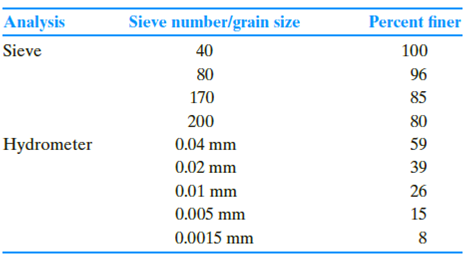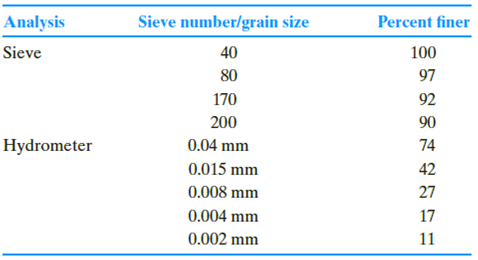
Bundle: Principles Of Geotechnical Engineering, Loose-leaf Version, 9th + Mindtap Engineering, 2 Terms (12 Months) Printed Access Card
9th Edition
ISBN: 9781337583817
Author: Braja M. Das, Khaled Sobhan
Publisher: Cengage Learning
expand_more
expand_more
format_list_bulleted
Concept explainers
Textbook Question
Chapter 2, Problem 2.9P
Repeat Problem 2.8 using the following data.

2.8 The following are the results of a sieve and hydrometer analysis.

a. Draw the grain-size distribution curve.
b. Determine the percentages of gravel, sand, silt and clay according to the MIT system.
c. Repeat Part b according to the USDA system.
d. Repeat Part b according to the AASHTO system.
Expert Solution & Answer
Trending nowThis is a popular solution!

Students have asked these similar questions
what is admixture and what are the characteristics of it explain in detail
Robert Moses is one of the most influential—and controversial—figures in American urban planning history. His imprint on New York City and its surrounding regions remains evident in highways, parks, bridges, and housing policies. However, his approach to planning often excluded public input and disproportionately harmed communities of color and low-income populations. This assignment challenges you to reflect critically on Moses’ legacy and draw connections to contemporary urban planning challenges.
Reflect on Power and Authority in Planning:
How did Robert Moses’ accumulation and use of unelected power shape the urban landscape of New York? What lessons can modern planners learn about checks and balances in urban development?
Community Impact Analysis:
Identify and discuss at least one community or population that was negatively impacted by Moses' planning decisions. What were the long-term effects on that community? How might a more equitable planning process have changed the…
After watching the video "The Rise and Fall of Robert Moses" (Vox), write a 1-page (approximately 500 words) double-spaced response that addresses the following:
Reflect on Power and Authority in Planning:
How did Robert Moses’ accumulation and use of unelected power shape the urban landscape of New York? What lessons can modern planners learn about checks and balances in urban development?
Community Impact Analysis:
Identify and discuss at least one community or population that was negatively impacted by Moses' planning decisions. What were the long-term effects on that community? How might a more equitable planning process have changed the outcome?
Contemporary Relevance:
Can you identify a current or recent urban planning decision (local, national, or international) that echoes the same issues of power, displacement, or inequity? Compare the two and discuss how modern planners might address these concerns differently.
Chapter 2 Solutions
Bundle: Principles Of Geotechnical Engineering, Loose-leaf Version, 9th + Mindtap Engineering, 2 Terms (12 Months) Printed Access Card
Ch. 2 - For a gravel with D60 = 0.48 mm, D30 = 0.25 mm,...Ch. 2 - Prob. 2.2PCh. 2 - Prob. 2.3PCh. 2 - The following are the results of a sieve analysis....Ch. 2 - Repeat Problem 2.4 with the following data. 2.4...Ch. 2 - Repeat Problem 2.4 with the following data. 2.4...Ch. 2 - Repeat Problem 2.4 with the following data. 2.4...Ch. 2 - The following are the results of a sieve and...Ch. 2 - Repeat Problem 2.8 using the following data. 2.8...Ch. 2 - Repeat Problem 2.8 using the following data. 2.8...
Ch. 2 - The grain-size characteristics of a soil are given...Ch. 2 - Repeat Problem 2.11 with the following data. 2.11...Ch. 2 - Repeat Problem 2.11 with the following data. 2.11...Ch. 2 - A hydrometer test has the following result: Gs =...Ch. 2 - Repeat Problem 2.14 with the following values: Gs...Ch. 2 - Three groups of students from the Geotechnical...Ch. 2 - Refer to Problem 2.C.1. Results of the sieve...
Knowledge Booster
Learn more about
Need a deep-dive on the concept behind this application? Look no further. Learn more about this topic, civil-engineering and related others by exploring similar questions and additional content below.Similar questions
- Please answer the question in the picture and make sure your work is correct please. Thank youarrow_forwardSolve the problem in the picture please only solve the part for the wall load at assuming rigid diaphragm please. Make sure you do the right work and show all of your work please. Thank you!arrow_forwardPlease solve this and make sure you show all of your work, Thank you for your help!arrow_forward
- 15'-0" 15'-0" Architect specifications: 1) Superimposed dead load (including finishes, partition, mep etc) for each floor are shown next page. 2) The facade weight is 200 plf and it's all around the building, the parapet weight at the roofs is 100 plf. Don't forget to add these loads at the perimeter beams. 3) Wind Load is 30 psf 4) Use steel or LVL for beams, TJI of common wood for joists. 5) Submit your calc package by Sunday May 11th ALL STRUCTURAL ITEMS IN RED ARE PART OF THE GRAVITY SYSTEM ALL STRUCTURAL ITEMS IN BLUE ARE PART OF THE LATERAL SYSTEM I 10'-0" 2 10'-0" 10'-0" B I I I LAYOUR FOR OFFICES Things Required Dead and Live Load Schedule Gravity design for office floor - Load calculations (DL + LL + facade load if on perimeter) Beam sizing Joist spacing/type (TJI or LVL) Provide calculations for: Reaction forces Maximum moments Shear • Beam sizes (steel or LVL) Key Map of elements (your office layout plan with beam/joist marks) Iarrow_forwardplease solve the problem in the picture make sure you show all of your work, thank you so much for your help!arrow_forwardPlease solve the question in the picture make sure you show all of your work and show every step you do please. Thank you so much for your help!arrow_forward
- Please answer the question in the picture. solve for the ground level and also for the 2nd level please. Make sure to show all of your work. Thank you for your help!arrow_forwardQ3: Assuming the length of all vehicles is 6 m and the road length is 300 m, determine: SMS, TMS, Density, average spacings between vehicles and average headway at A- A section. 50 kph Veh 4 70 m 40 kph Veh 3 60 m 30 kph Veh 2 20m 25 kph A Veh 1 Traffic direction A (40 marks)arrow_forwardThe drainage system shown in fig 14.35 is designed to collect the stormwater from 3 atreas The areas runoof coefficients and overland flow times are as follows The rainfall intensity i (mm/h) as a function of rainfall duration t(min) is i =1.12/t+110 The flow time in sewer 1-2 is 2min and in sewer 2-3 is 2.5 minarrow_forward
- Please answer the question from the picture, show each step and explain please. Thank you so mucharrow_forwardFigure 1 shows the plan view of an Exhibition Hall with dimensions L1 x L2. The structure is to be constructed in a coastal region which will be exposed to mostly mild environmental conditions and should provide a 1.5-hour fire resistance. It is known that the underlying foundation soil contains sulphate and other organic compounds. The layout of the structure consists of portal frames which are spaced evenly along the L2 direction. The frames are to support a slab of thickness (t) that will cover the full area of the hall plan. The dead and live loads applied on the slab are G and Q (kPa), respectively.arrow_forwardA sample of Achilles saturated with water has a mass of 1710 g. After heating in an oven, a constant mass of 1815 g is obtained. The density of solid Achilles seeds is 2.78 g/cm3. We are asked to calculate: a) The water content and void ratio b) The porosity and specific gravity of the clayey soil c) The wet density of the clayey soil, the corresponding dry density and dry densityarrow_forward
arrow_back_ios
SEE MORE QUESTIONS
arrow_forward_ios
Recommended textbooks for you
 Principles of Geotechnical Engineering (MindTap C...Civil EngineeringISBN:9781305970939Author:Braja M. Das, Khaled SobhanPublisher:Cengage Learning
Principles of Geotechnical Engineering (MindTap C...Civil EngineeringISBN:9781305970939Author:Braja M. Das, Khaled SobhanPublisher:Cengage Learning Principles of Foundation Engineering (MindTap Cou...Civil EngineeringISBN:9781337705028Author:Braja M. Das, Nagaratnam SivakuganPublisher:Cengage Learning
Principles of Foundation Engineering (MindTap Cou...Civil EngineeringISBN:9781337705028Author:Braja M. Das, Nagaratnam SivakuganPublisher:Cengage Learning Fundamentals of Geotechnical Engineering (MindTap...Civil EngineeringISBN:9781305635180Author:Braja M. Das, Nagaratnam SivakuganPublisher:Cengage Learning
Fundamentals of Geotechnical Engineering (MindTap...Civil EngineeringISBN:9781305635180Author:Braja M. Das, Nagaratnam SivakuganPublisher:Cengage Learning Construction Materials, Methods and Techniques (M...Civil EngineeringISBN:9781305086272Author:William P. Spence, Eva KultermannPublisher:Cengage Learning
Construction Materials, Methods and Techniques (M...Civil EngineeringISBN:9781305086272Author:William P. Spence, Eva KultermannPublisher:Cengage Learning Traffic and Highway EngineeringCivil EngineeringISBN:9781305156241Author:Garber, Nicholas J.Publisher:Cengage Learning
Traffic and Highway EngineeringCivil EngineeringISBN:9781305156241Author:Garber, Nicholas J.Publisher:Cengage Learning Principles of Foundation Engineering (MindTap Cou...Civil EngineeringISBN:9781305081550Author:Braja M. DasPublisher:Cengage Learning
Principles of Foundation Engineering (MindTap Cou...Civil EngineeringISBN:9781305081550Author:Braja M. DasPublisher:Cengage Learning

Principles of Geotechnical Engineering (MindTap C...
Civil Engineering
ISBN:9781305970939
Author:Braja M. Das, Khaled Sobhan
Publisher:Cengage Learning

Principles of Foundation Engineering (MindTap Cou...
Civil Engineering
ISBN:9781337705028
Author:Braja M. Das, Nagaratnam Sivakugan
Publisher:Cengage Learning

Fundamentals of Geotechnical Engineering (MindTap...
Civil Engineering
ISBN:9781305635180
Author:Braja M. Das, Nagaratnam Sivakugan
Publisher:Cengage Learning

Construction Materials, Methods and Techniques (M...
Civil Engineering
ISBN:9781305086272
Author:William P. Spence, Eva Kultermann
Publisher:Cengage Learning

Traffic and Highway Engineering
Civil Engineering
ISBN:9781305156241
Author:Garber, Nicholas J.
Publisher:Cengage Learning

Principles of Foundation Engineering (MindTap Cou...
Civil Engineering
ISBN:9781305081550
Author:Braja M. Das
Publisher:Cengage Learning
How Are Highways Designed?; Author: Practical Engineering;https://www.youtube.com/watch?v=9XIjqdk69O4;License: Standard Youtube License